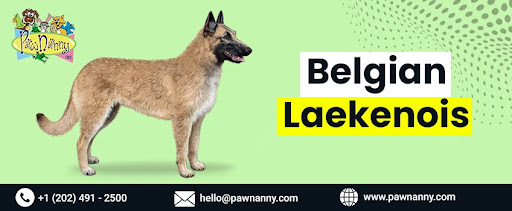
Belgian Laekenois
Group: Herding Group
Size: 22-26 inches
Weight: 55–65 pounds (25–29 kg)
Hypoallergenic: No
Lifespan: 10–12 years
Behavior
The Belgian Laeken is an active working dog breed developed to guard the royal castle at Laeken in Belgium. This breed is characterized as focused, highly intelligent, and attentive to commands as they are herding. It is truly associated with its parents and fond of being occupied with something. Lack of stimulation, exercise, and training can make these dogs bored or destructive. Regular checks, like for Pet Anal Gland Expression Services, are necessary with this breed.
The Laekenois are very devoted and guard your family members very well. They are generally shy and unconversant with strangers, people, and animals they have not met before, but they are not usually hostile. The Laekenois can be socialized with other people and animals they have not met if the process is initiated from an early age of the dog. But they are always on guard. They have their herding instinct and may bite or chase small animals or children if not well restrained. When properly trained, the Laekenois makes an excellent guard dog on a farm and a search and rescue, police, or show dog.
History
The Belgian Laekenois is one of four types of Belgian shepherd dogs and originated in Belgium. The Laekenois was bred primarily as a drover, used on the farms to guard animals and the property. It originated in the Laeken district in Brussels in the 1800s but isn’t all that popular today. For many years, the Belgian breeds were not distinguished, and all the dogs were called “Chiens de Berger Belge” or the Belgian Shepherd. However, it was not until the end of the 19th century that serious attempts were made to categorize them into breeds according to coat texture and place of origin. Laekenois’s rough-coated breed appeared before it was made official in Belgium in 1891.
Unfortunately, during the World Wars, the Laekenois expert was reduced to the utmost skirts of extinction. There were relatively few working dogs left on farms by the time Pettersson made his survey. The breed’s population dipped so low that a breed club had to step in and restore the breed population in the 1960s. It was known internationally in the 1970s and the breed became accepted by major kennel clubs.
Today Belgian Laekenois are still employed as the herding and guarding dogs. They also make good police, search and rescue, and companion dogs. They are watchful guard dogs with bounding and deep inherent temperaments. The dogs have an outer coat that suits them for outdoor working conditions and cold environments.
Exercise
Belgian Laekenois is an energetic dog that needs lots of exercise. A good goal is to give this breed at least an hour of vigorous activities such as running, hiking, and playing with Fetch. Ironically, the Laekenois like to have a job, so they create opportunities for their herding skills. Stimulate their brain as well through training or playthings as well as through their food bowl. This highly intelligent and energetic breed doesn’t get enough physical and mental activity and can become bored or destructive. When it comes to activity, your Laekenois will need their needs met with an active dog lifestyle while being kept structured so that they stay healthy, mentally sound, and happy. Allow them to play a lot around a fence or take them for a walk at least several times a day. Laekenois are active dogs that need frequent serious exercise sessions and enjoy playing with their parents or guardians!
Training
Belgian Laekenois is a sensitive, smart, and highly active breed that demands lots of exercise and training and must be trained and socialized from an early age. Because they were bred to be working dogs used for moving livestock, Laekenois pups should then be trained using basic commands such as sit, stay, and come, where the method used is reward-based with food and praise.
This is a very high-energy dog and will happily live any activity you choose to give them with the additional advantage of mentally engaging you with agility, obedience, or bike riding. Introducing yourself as the strong master and creating a well-outlined pack with well-defined standards is essential in dealing with this strong-willed breed.
Looks and Health
Belgian Laeken has a medium-large, fairly square body and noble expression. They have an undercoat with longer hair around the neck, which resembles a mane or ruff, and feathers all through fur on lower limbs, tail, and ears. The hair is medium length, fawn to mahogany red - hence black hairs appear on the muzzle and tail. The muzzle is pointed. Their eyes are auricular, large, slightly almond-shaped, and medium-sized. Erect triangular ears are also present. When moving, the tail is held high and curled. The Laekenois has a certain fluidity in its body movement. It has no problem jumping, running, or moving and looks energetic. In general, the Laekenois is intelligent, energetic, and quick, with the build of a worker dog perfect for farm life.
The Belgian Laekenois is a healthy breed. Health problems that are common in the breed include Hip dysplasia, Elbow dysplasia, Progressive retinal atrophy and cataracts, Epilepsy, or skin allergic diseases. Responsible breeders will have breeding dogs scanned for these diseases to reduce the chances of their occurrence. Due to their working/herding roles, the Laekenois are a muscular and athletic breed, but this also means that young dogs that have yet to have their growth plates closed can more easily develop injuries such as torn ligaments or dislocated joints if exercised too vigorously. This breed is innately active and thus requires regular visits to the vet, and screening before and during breeding programs makes this breed age very well.
Food and Nutrition
A Belgian Laekenois is an exploring working breed that must be fed a diet of nutrients to sustain energetic activity. These dogs have an increased metabolic rate and require lots of good quality protein or sources like chicken, beef, fish, and eggs. Adults do best on high-quality commercial dog food that contains all the nutrient balance that should go to an active breed. To sustain muscle rigidity and energy demand, you should use food with a quality protein of not less than 20% and 10-15% fat. This breed is still metabolically active, but unfortunately, gaining weight is very easy, so regularly exercising and rationing treats would be necessary. For adequate digestion and a proper assessment of nutrients, fresh water should be available at all times with regular Express Anal Glands Services checkups.
Conclusion
The Belgian Laekenois is a herding breed used for all types of work - they are loyal companion and family pets. However, they should have chances for daily physical and mental activity; still, they are at ease working in the country, leaving a farm gate open and living in a suburb. Laekenois are referred to as playful, and if correctly grown around other people from an early age, they readily form very close relationships with human families, besides being excellent guards’ dogs. Their high intelligence also qualifies them for the dog sports of agility, obedience trials, tracking, and herding. The proud and hardworking Belgian Laekenois may be the dog that someone looking for an energetic dog with a protective nature will want. For more information or to avail of our Pet Anal Gland Expression Services USA, visit PawNanny.com!










